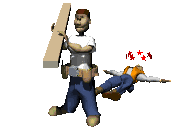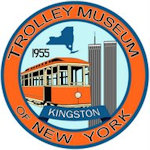
This site is non-profit and non-commercial. We are free of advertising on this site but there are costs in internet services. If you enjoy this site, we do need support.
Checks can be sent to: R. Donald
Ross, 3821 Crater Lake Ct, Irving, TX 75062-4015
Don's Rail
Photos
![]()


![]()

Under Construction
Trolley Museum of New York

It was started in 1955 at Brooklyn but they had a hard time to fine a place. It was stored it several places and went to Staten Island about 1960. When that unavailable area some their equipment was sold. Then they had the use of some space on South Brooklyn Ry but that ended shortly. Some of the cars went to Trolley Valhalla Museum but that lease didn't last long. Then they plan to move to Morristown & Erie RR in 1969 but the railroad went to bnnkruptcy. In 1972 it was going to move to Coney Island Shops but there was a new manager and he didn't accept the idea of a museum. They were offered 3 cars at Philadelphia but SEPTA scrapped before they were moved. Newspapers found out what happened and the mayor of Kingston read it and set up the papers. It was set up trackage in 1983. The city realized that some if the cars deteriored and some was just plain junk. Then a storm hit in 2012. In 2014 the angel came and realized the value of the equipment. He decided it was time to help. Reorganizing seems to be the success that was needed.
3 was built by Maschinenbau-Actiengeselschaft Nurnburg, body, and Schuckert, electrical equipment, in 1897 as Kristiania Elektriscke Sporvei 3. It became Kristiania Kommunale Sporvei in 1899 and became Oslo Sporveier in 1924. It was brought to US in about 1970. It was purchased by George E Hassoldt and went to Brooklyn.
The first run of the BRHA took place on September 1st, 1999, when car 3 took to the rails under overhead power. This car had been built for Oslo, Norway, in 1897, and was imported to the US by Arthur Seifert in 1970. He restored the car in his back yard, and it has been stored at various locations since. He sold it to George Hasselholt. It operated for a short time on the Jay Street Connecting RR under the Manhattan Bridge, using a long jumper cable. It is now on permanent loan to the BRHA. The original pantagraph was replaced with a pole trolley. The car runs very well. Oslo has two cars of this type in their museum as non-operating displays.This car features dynamic braking and a hand brake for the final stop. This was a common practice in Europe and also on the West Penn in Pennsylvania. The body was built of wood in the local shop and outfitted by a predecessor of the German bus builder MAN. It is set up for a trailer as in the common practice in Europe.
250 was built by Brill In 1917, #20663, as Southwestern Co 5500. It was sold as Ocean Electric Ry in 1922 and sold as Atlanta City & Shore 6850 in 1928 and became Atlantic City Transportation Co 250 in 1949. It was retired in 1955 and acquired by TMNY in 1955. It was acquired by Branford Electric Ry Assn in 2007 and then acquired by North Jersey Electric Railway Historical Society in 2018.
1000. One of the first systems to purchase PCCs was the Brooklyn & Queens Transit, but they never got beyond the original cars. They also had a unique car, 1000. Clark Equipment Co. manufactured many of the trucks used under PCCs, but they only built one complete car. We start with a photo of it. It has been preserved but is not in good condition at this time. In addition, the original front end was replaced after an accident during the war. It was sent to the Trolley Museum of New York in 1956 and went to Kingston in 1991.
1504 was built by Atelliers Metallurgiques de Nivelles in 1938 for Societe des Transports Intercommaux de Bruxelles. It was sent to TMNY in 1984.
WebWork by ![]() rinity
rinity
![]() echnology Co.
echnology Co.
AMDG
10/5/2021
Memorial of Saint Alexander of Trier
<><
Choose Life.
Mom did.
Home Page
Don's Depot
Be one of the small number who find the way to life, and enter by the narrow gate into Heaven. Take care not to follow the majority and the common herd, so many of whom are lost. Do not be deceived; there are only two roads: one that leads to life and is narrow; the other that leads to death and is wide. There is no middle way.
— St. Louis de Montfort